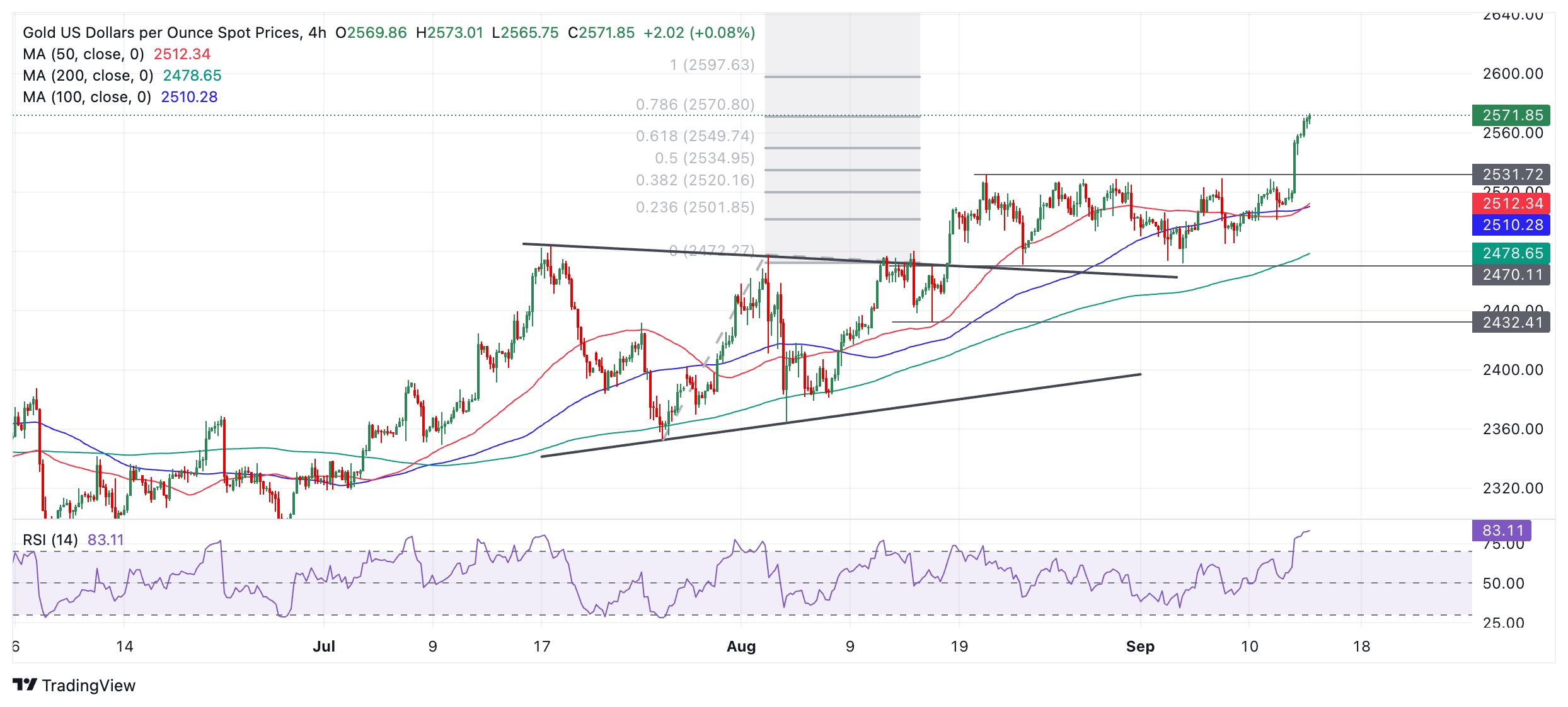Gold rallies as media revives debate over Fed rate cuts

- Gold is hitting record highs on Friday as markets debate anew whether the Fed will cut by 50 or 25 basis points in September.
- The revival of the possibility of a “jumbo” 0.50% cut fuels another rally in Gold.
- Gold’s broad uptrend resumes although momentum is flashing “overbought”.
Gold (XAU/USD) is exchanging hands in the $2,560s on Friday, trading about 0.40% higher on the day after posting new record highs on Thursday when it broke decisively out of a range it had been oscillating in since it peaked on August 20.
The initial catalyst for the breakout was the release of mixed “factory gate” price inflation data, or Producer Price Index (PPI) data out of the US for August. The figures showed a deeper-than-expected slowdown in headline PPI, and although core PPI remained sticky, the market reacted as if the data was disinflationary.
Gold extends rally after media reignites debate over 0.50% vs 0.25% Fed cut
Gold continued to rally during Friday’s Asian session due to the revival of the debate over whether the Federal Reserve (Fed) will cut interest rates by 0.50% or 0.25% at its meeting next Wednesday.
The release of still-high core consumer price inflation data, in the form of the Consumer Price Index (CPI) on Wednesday, had seemingly put to bed hopes of a “jumbo” 0.50% (50 pbs) cut. However, an article by a respected The Wall Street Journal (WSJ) Fed Watcher Nick Timiraos, as well as comments from former President of the New York Fed William Dudley, suggested a 0.50% should still be considered. This, in turn, led to a fall in US Treasury yields, a sell-off in the US Dollar (USD), and a rally in Gold’s price.
Lower interest rates are positive for Gold because it reduces the opportunity cost of holding the non-interest-bearing asset, making it more attractive to investors.
Technical Analysis: Gold pushes to record highs as broad uptrend resumes
Gold (XAU/USD) breaks out of its multi-week sideways range and surpasses the previous record highs of $2,531.
The longer-term trend for Gold is bullish, and according to technical analysis theory, since “the trend is your friend,” this favors a continuation of the uptrend.
XAU/USD 4-hour Chart
The precious metal has met its previous target at $2,550, generated after the original breakout from the July-August range on August 14, and now sets its sights on the next target at around $2,590.
Gold is overbought, however, according to the Relative Strength Index (RSI). This advises long holders not to add to their positions because of an increased risk of a pullback materializing.
If the RSI exits overbought, it will signal a correction is unfolding. If such a correction unfolds, it will likely find support either at the $2,550 prior target or firmer support lower at the $2,531 former high.
The trend on all timeframes remains bullish, however, suggesting any correction will eventually run out of steam and the broader uptrend will resume, pushing the yellow metal to new highs.
Gold FAQs
Gold has played a key role in human’s history as it has been widely used as a store of value and medium of exchange. Currently, apart from its shine and usage for jewelry, the precious metal is widely seen as a safe-haven asset, meaning that it is considered a good investment during turbulent times. Gold is also widely seen as a hedge against inflation and against depreciating currencies as it doesn’t rely on any specific issuer or government.
Central banks are the biggest Gold holders. In their aim to support their currencies in turbulent times, central banks tend to diversify their reserves and buy Gold to improve the perceived strength of the economy and the currency. High Gold reserves can be a source of trust for a country’s solvency. Central banks added 1,136 tonnes of Gold worth around $70 billion to their reserves in 2022, according to data from the World Gold Council. This is the highest yearly purchase since records began. Central banks from emerging economies such as China, India and Turkey are quickly increasing their Gold reserves.
Gold has an inverse correlation with the US Dollar and US Treasuries, which are both major reserve and safe-haven assets. When the Dollar depreciates, Gold tends to rise, enabling investors and central banks to diversify their assets in turbulent times. Gold is also inversely correlated with risk assets. A rally in the stock market tends to weaken Gold price, while sell-offs in riskier markets tend to favor the precious metal.
The price can move due to a wide range of factors. Geopolitical instability or fears of a deep recession can quickly make Gold price escalate due to its safe-haven status. As a yield-less asset, Gold tends to rise with lower interest rates, while higher cost of money usually weighs down on the yellow metal. Still, most moves depend on how the US Dollar (USD) behaves as the asset is priced in dollars (XAU/USD). A strong Dollar tends to keep the price of Gold controlled, whereas a weaker Dollar is likely to push Gold prices up.
